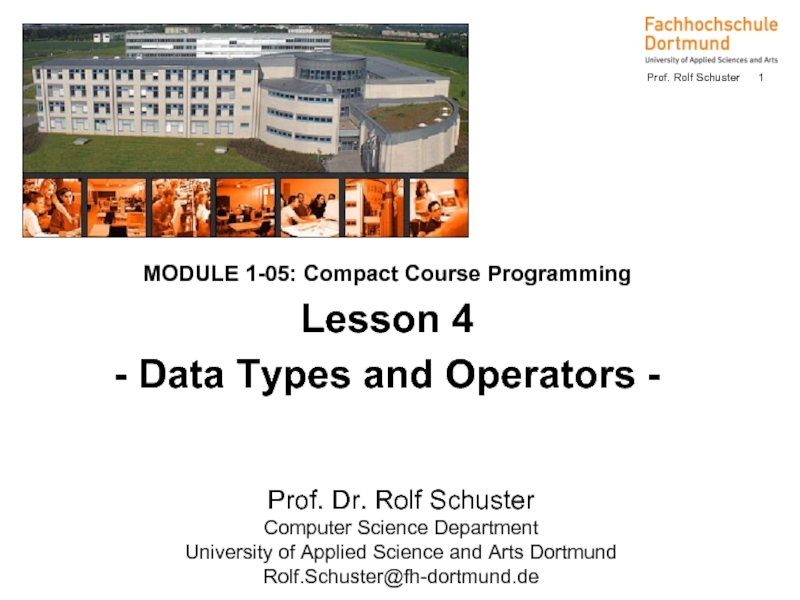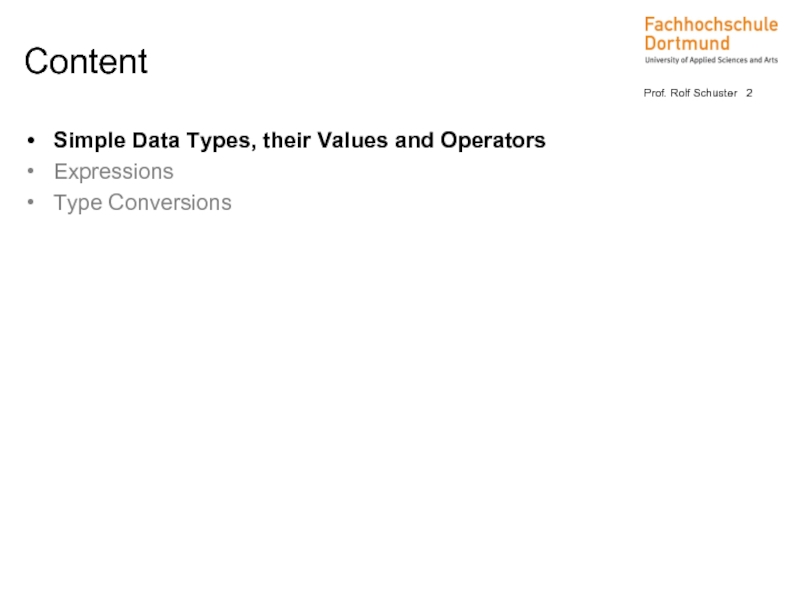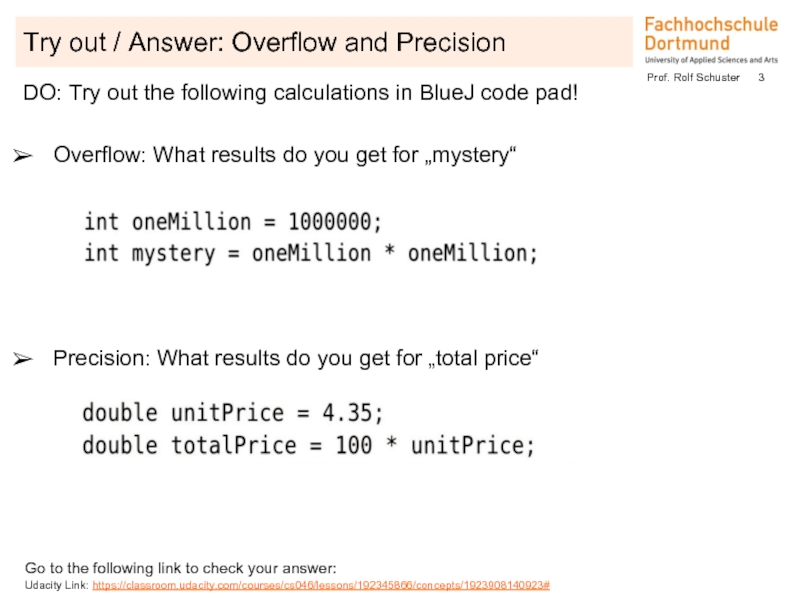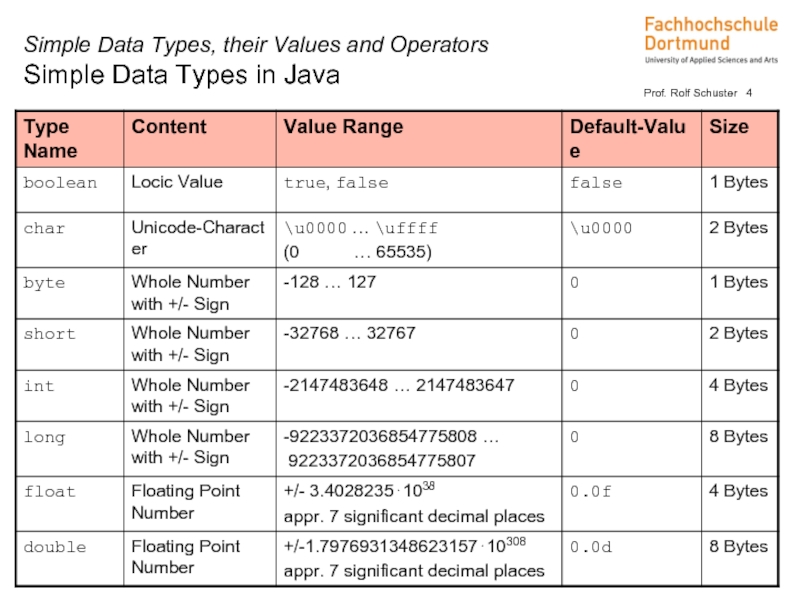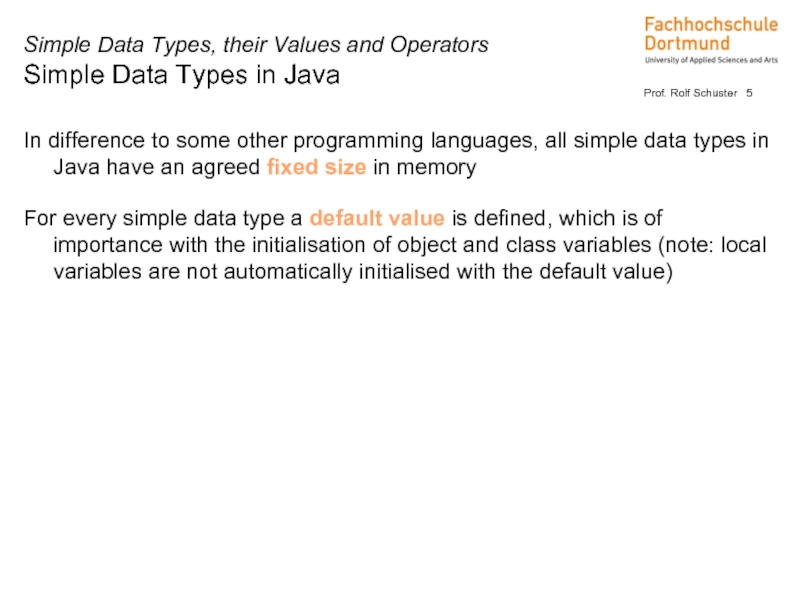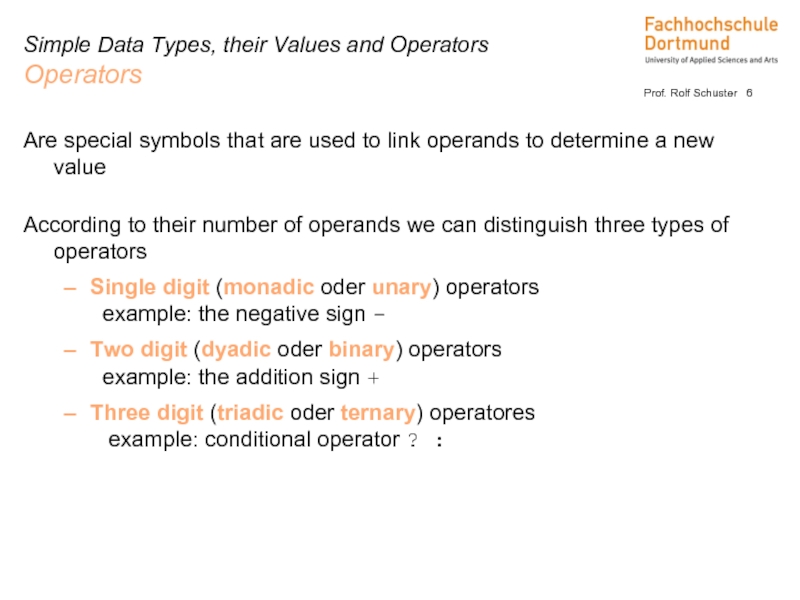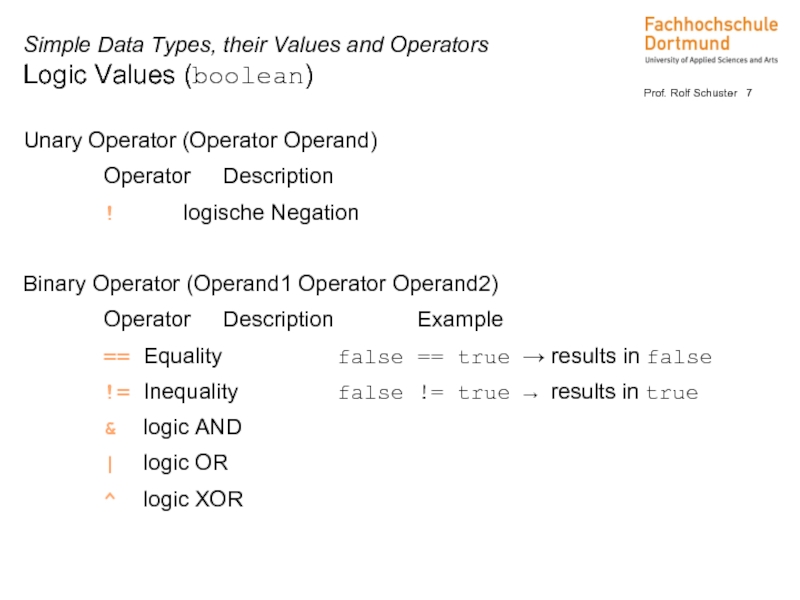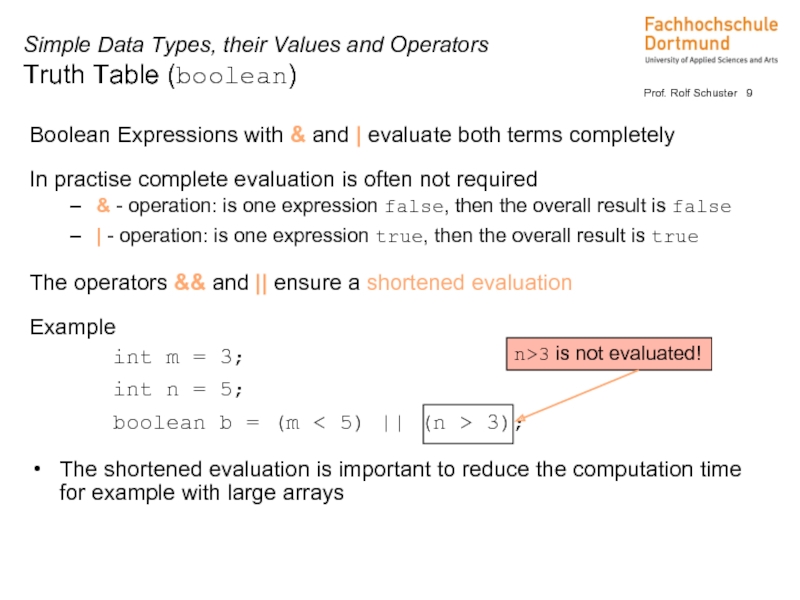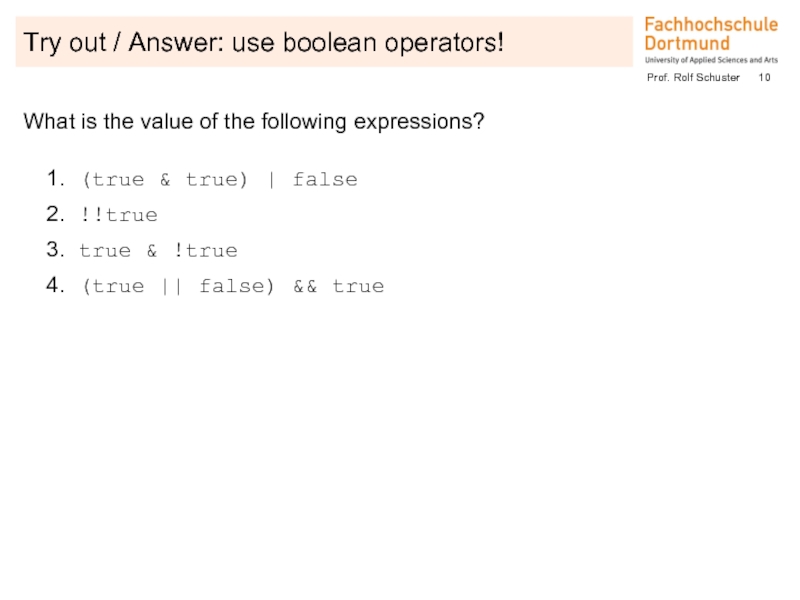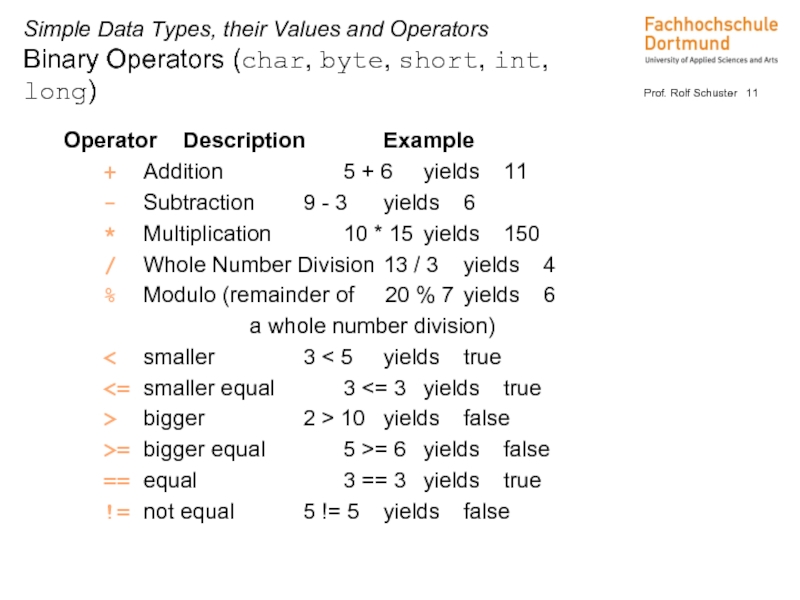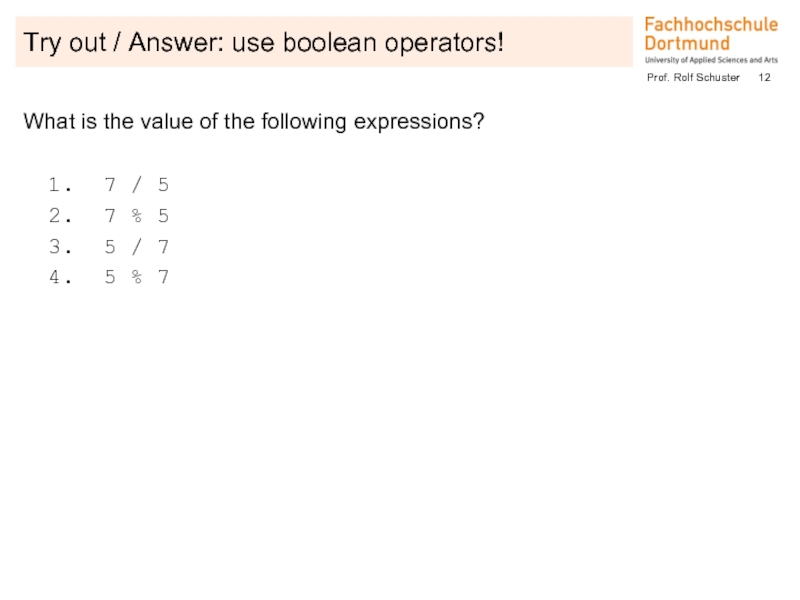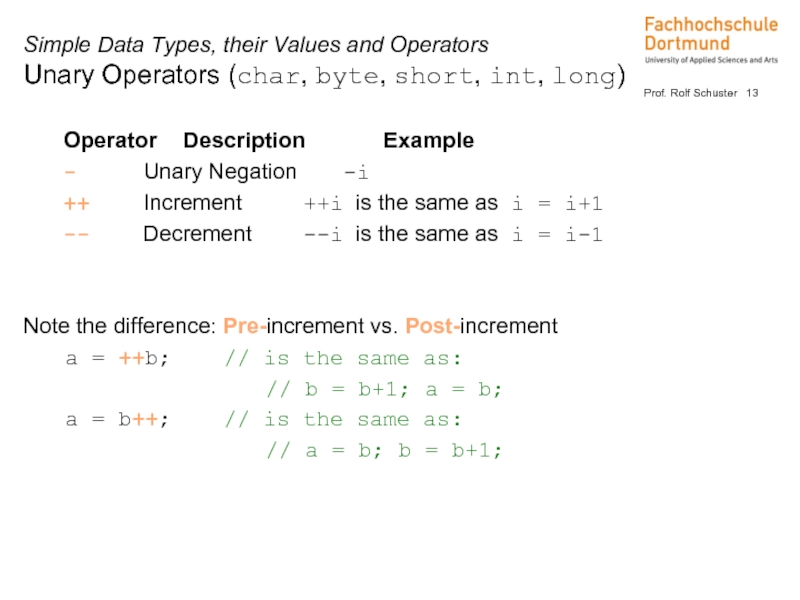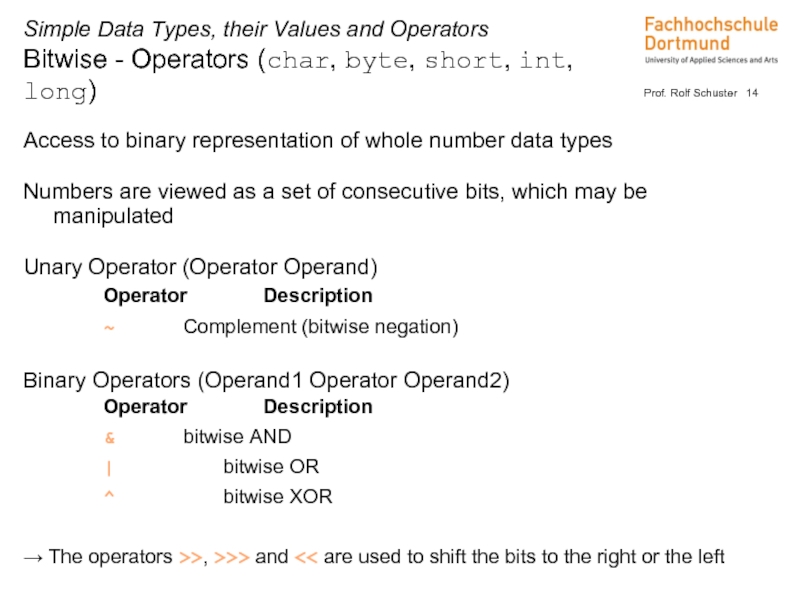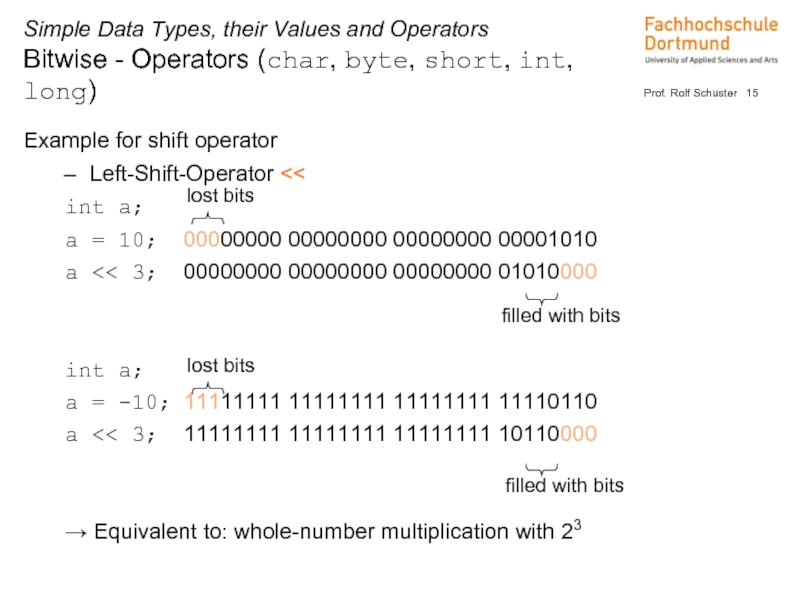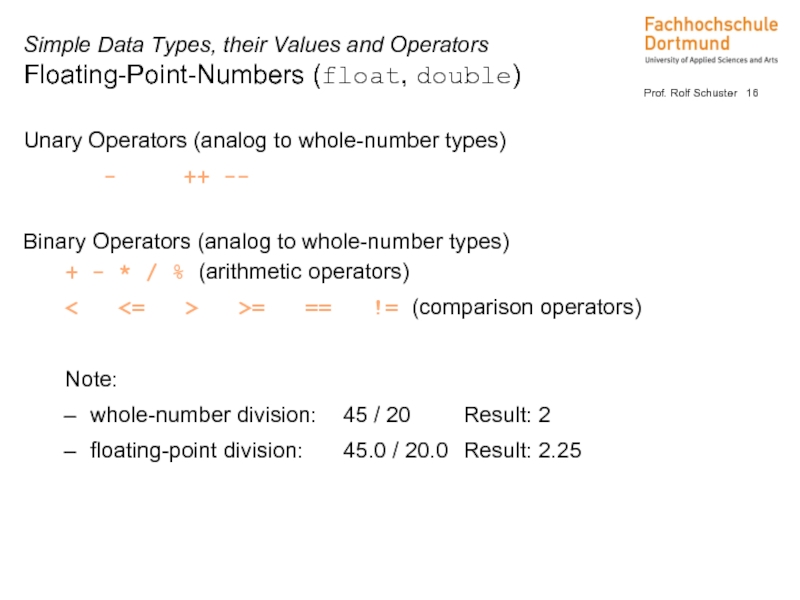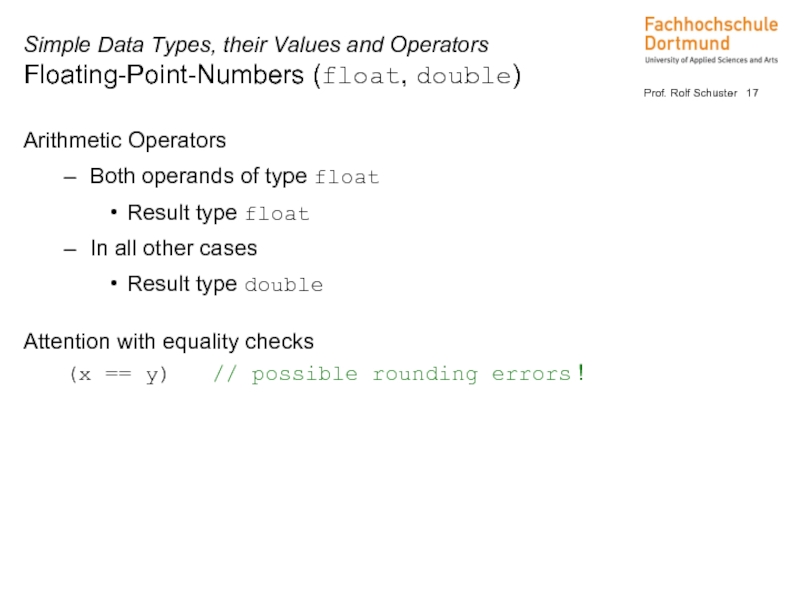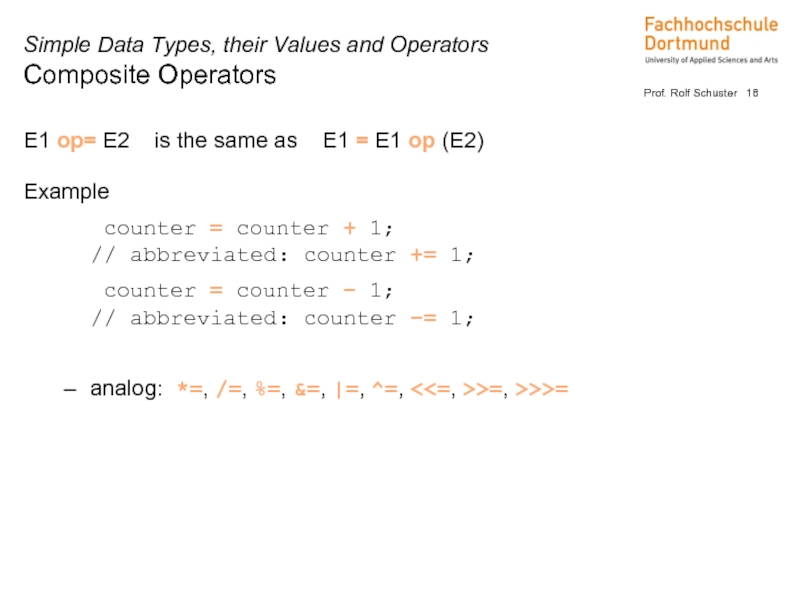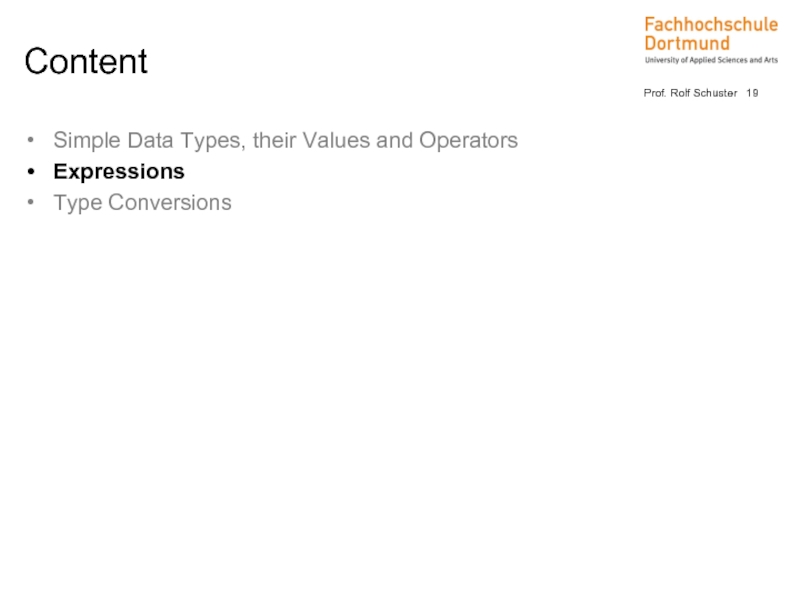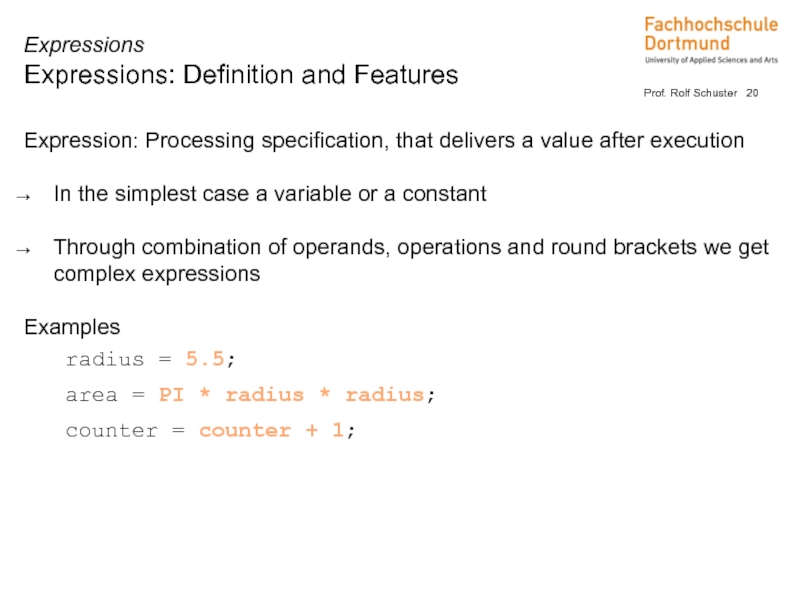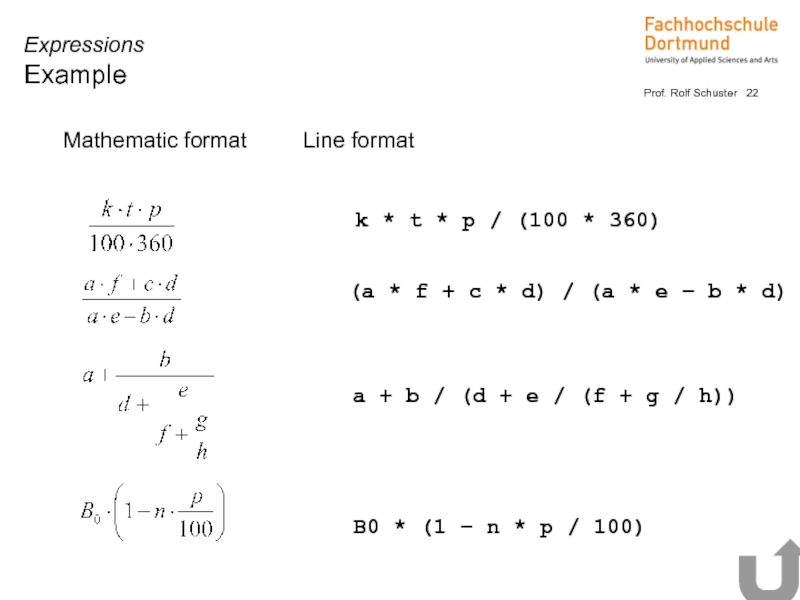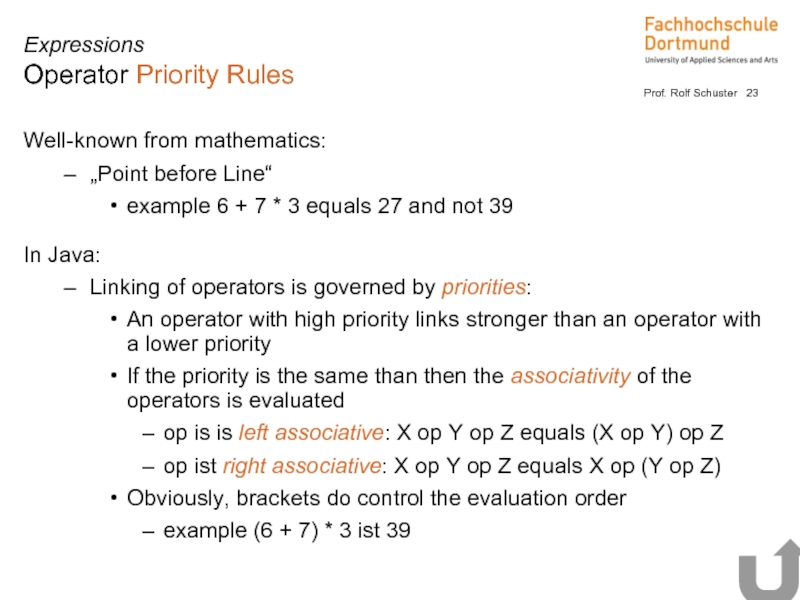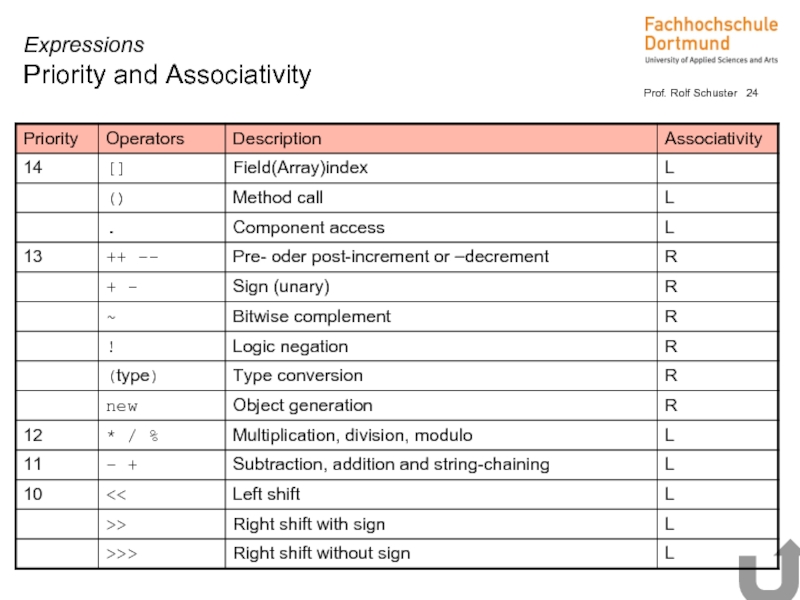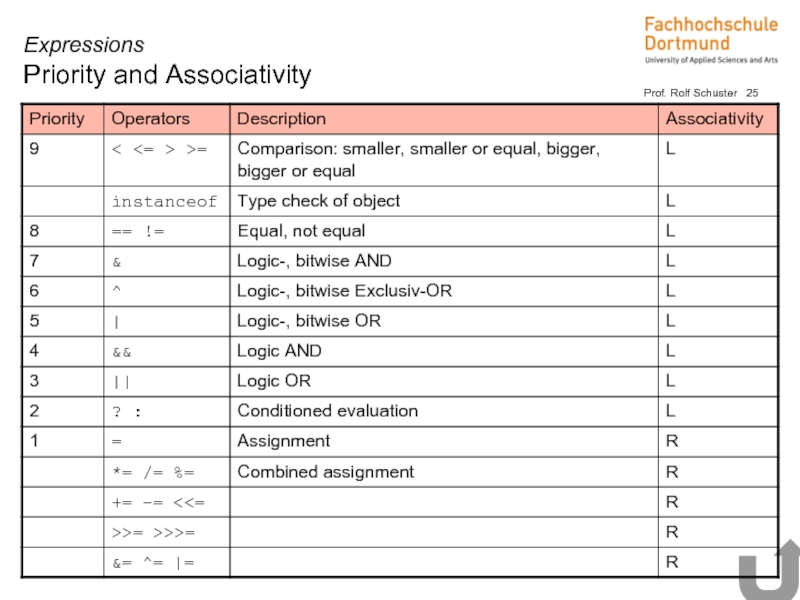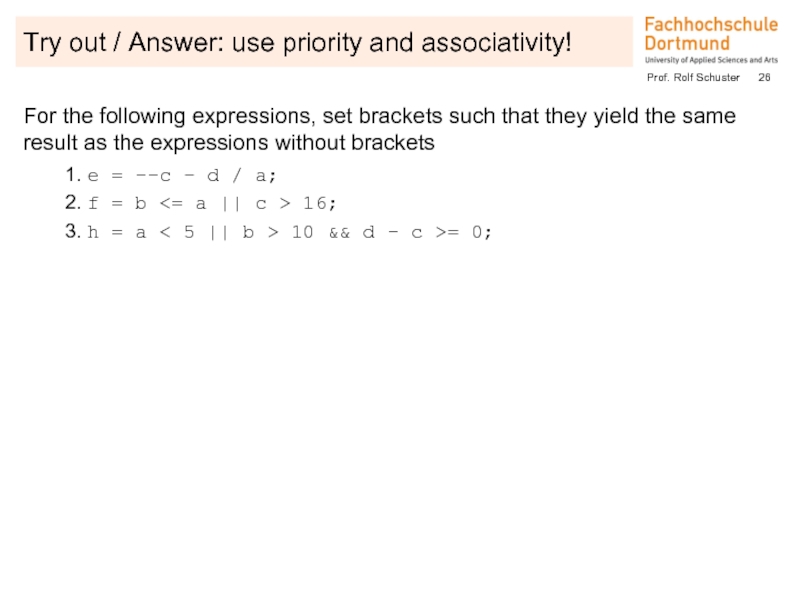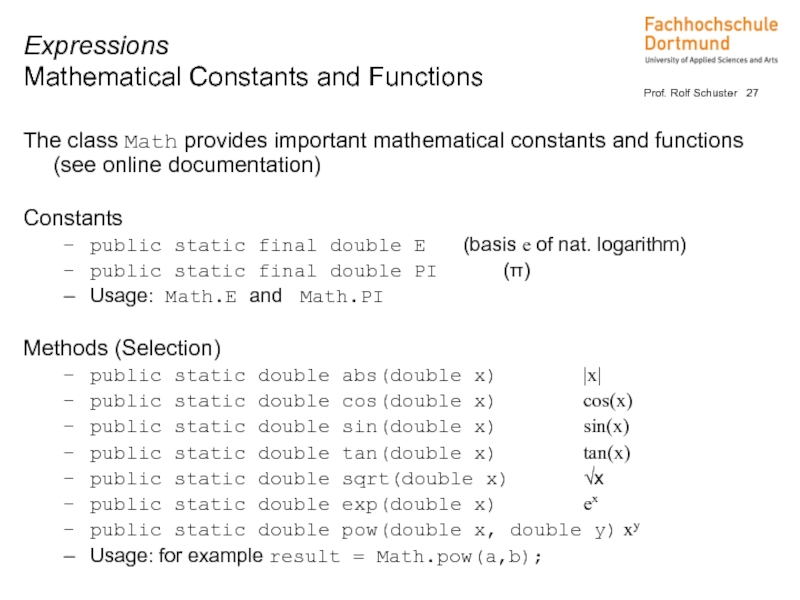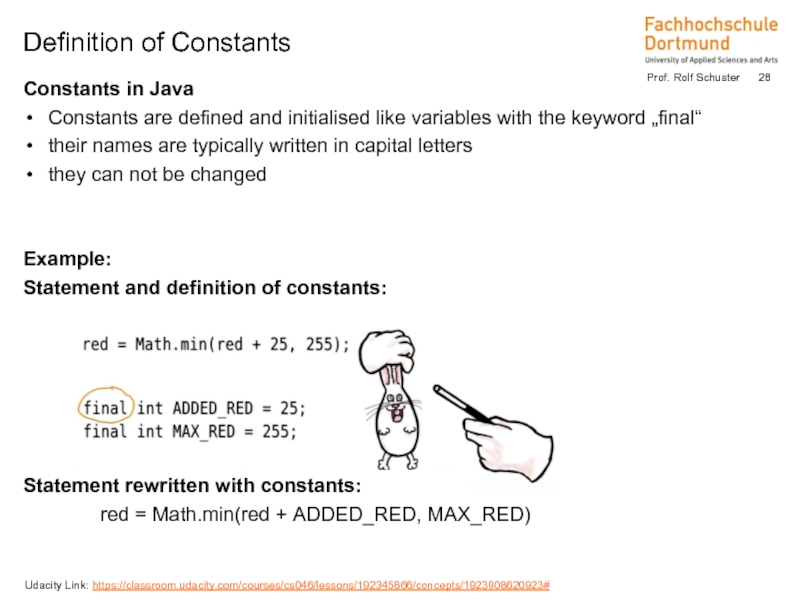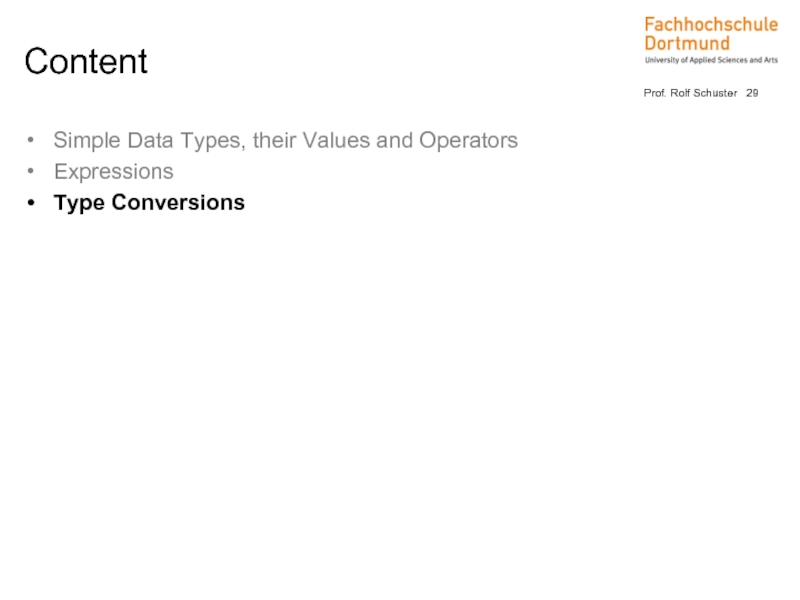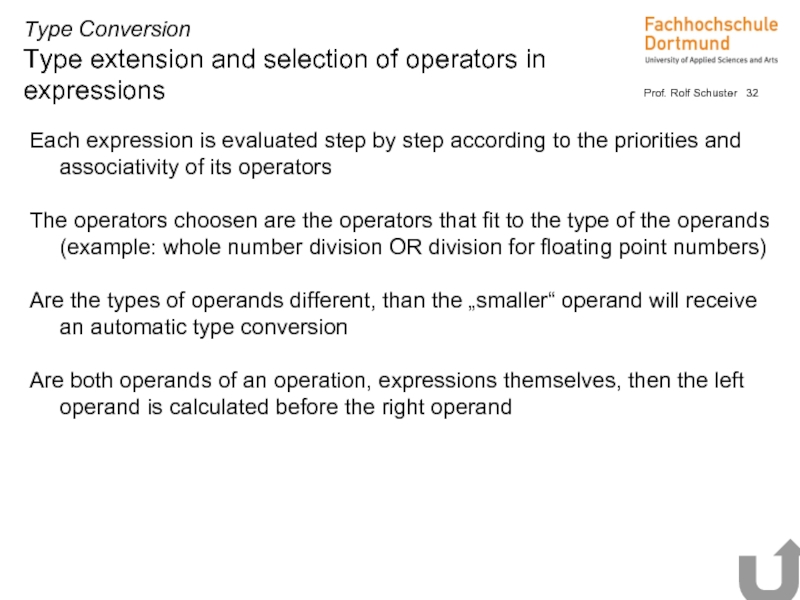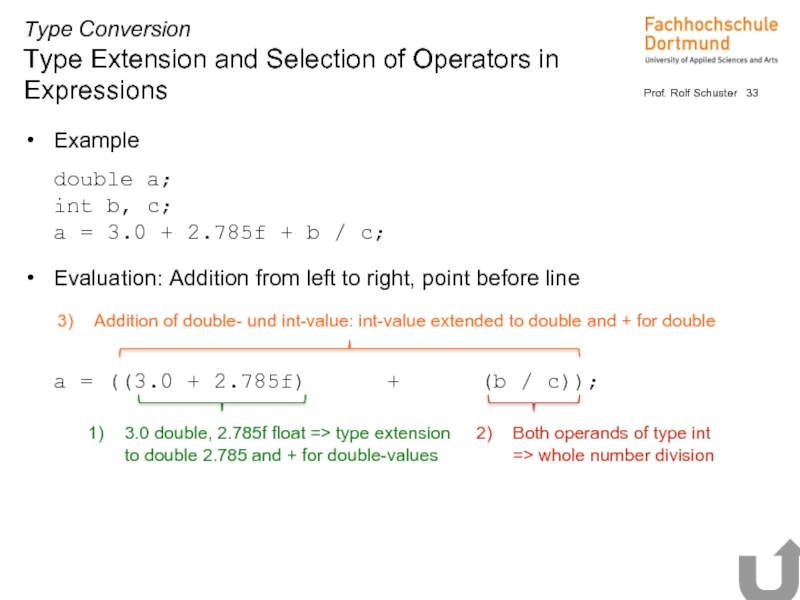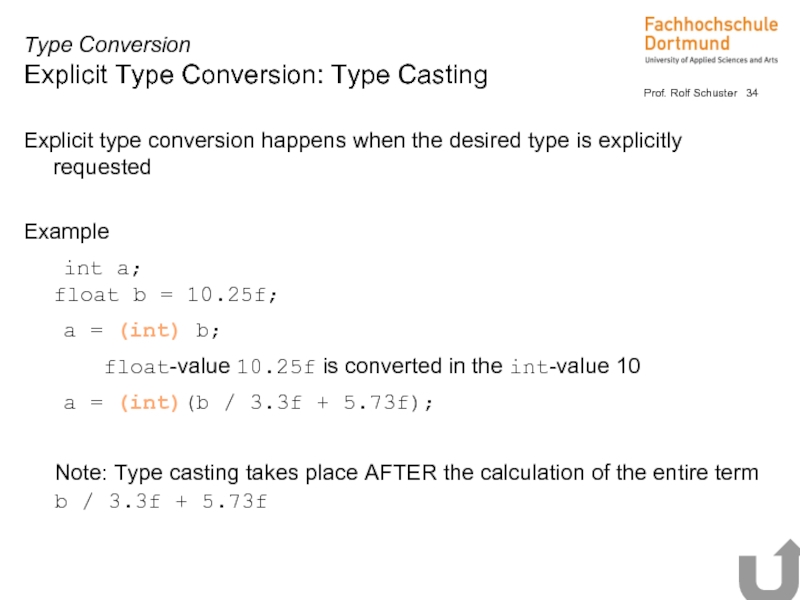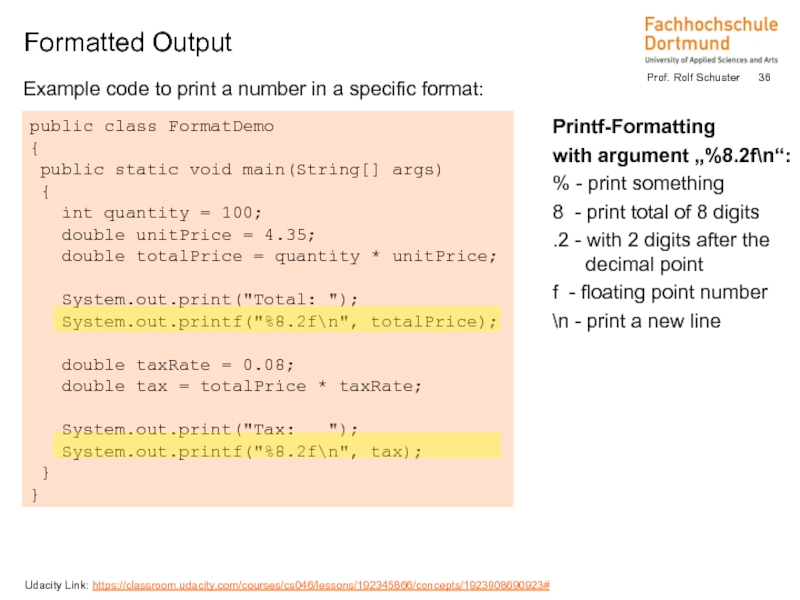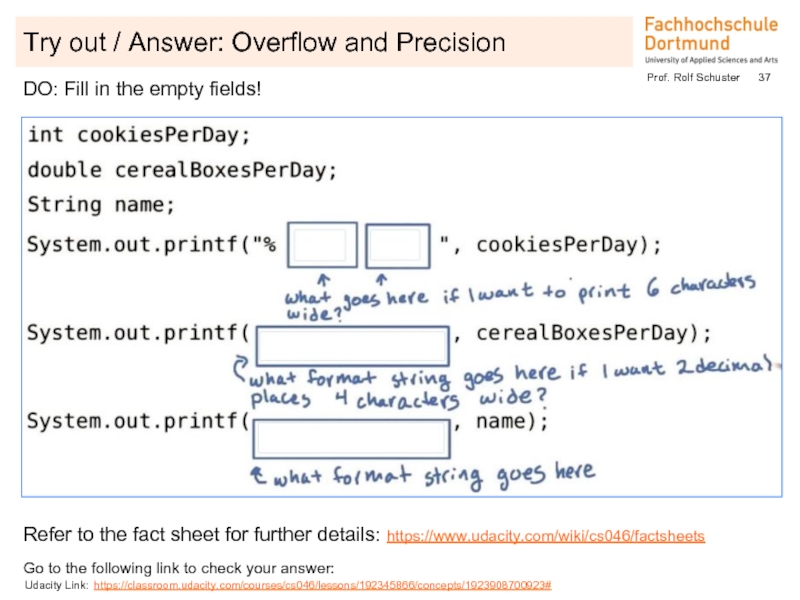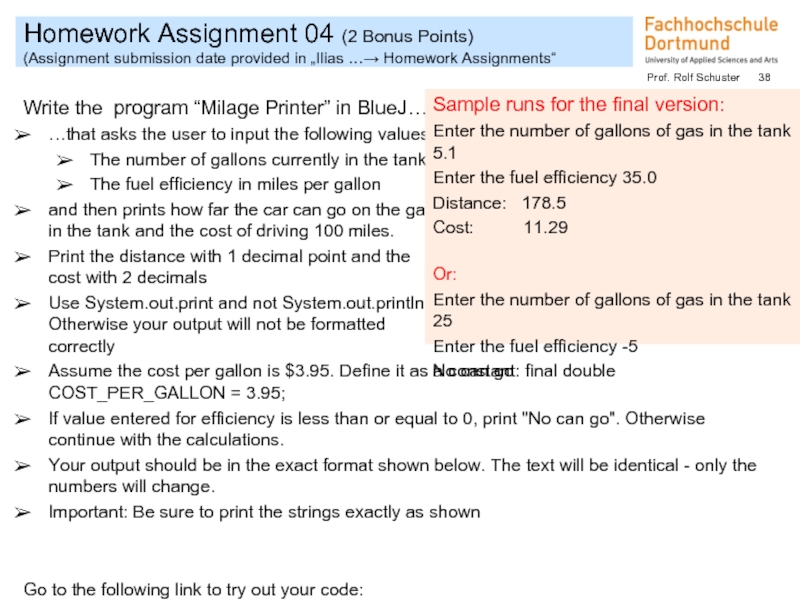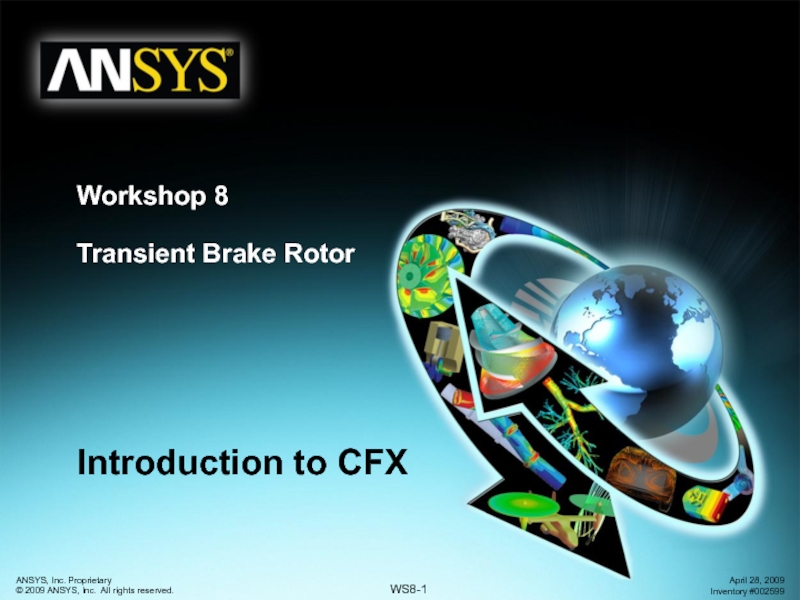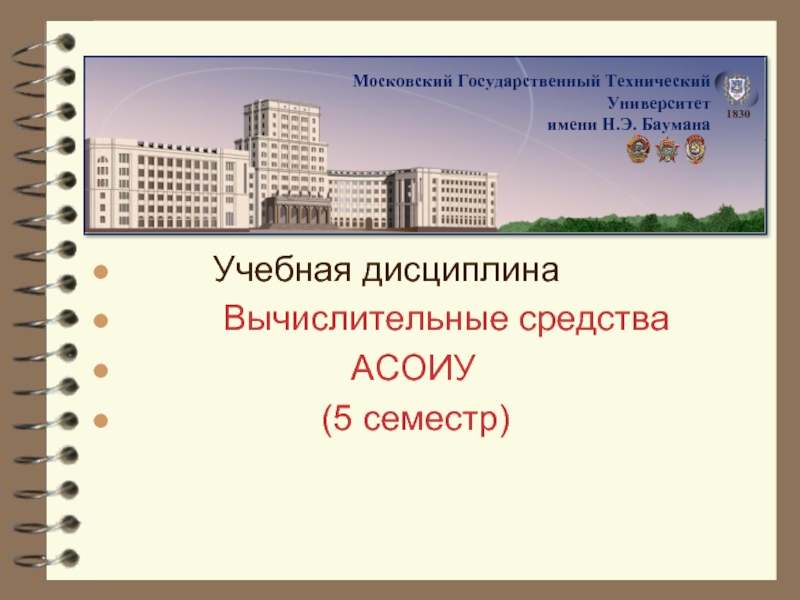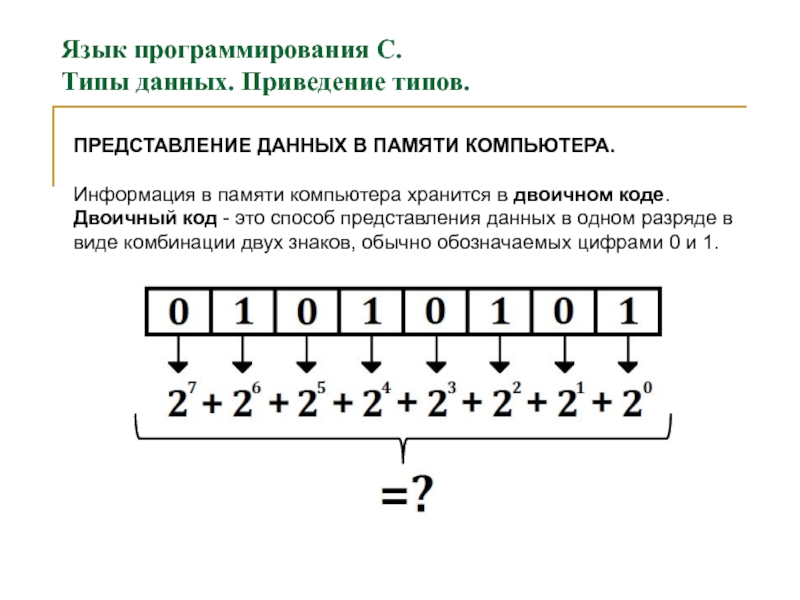- Главная
- Разное
- Дизайн
- Бизнес и предпринимательство
- Аналитика
- Образование
- Развлечения
- Красота и здоровье
- Финансы
- Государство
- Путешествия
- Спорт
- Недвижимость
- Армия
- Графика
- Культурология
- Еда и кулинария
- Лингвистика
- Английский язык
- Астрономия
- Алгебра
- Биология
- География
- Детские презентации
- Информатика
- История
- Литература
- Маркетинг
- Математика
- Медицина
- Менеджмент
- Музыка
- МХК
- Немецкий язык
- ОБЖ
- Обществознание
- Окружающий мир
- Педагогика
- Русский язык
- Технология
- Физика
- Философия
- Химия
- Шаблоны, картинки для презентаций
- Экология
- Экономика
- Юриспруденция
Data Types and Operators (Java, Lecture 04) презентация
Содержание
- 1. Data Types and Operators (Java, Lecture 04)
- 2. Simple Data Types, their Values and Operators Expressions Type Conversions Content
- 3. Try out / Answer: Overflow and Precision
- 4. Simple Data Types, their Values and Operators Simple Data Types in Java
- 5. In difference to some other programming languages,
- 6. Are special symbols that are used to
- 7. Unary Operator (Operator Operand) Operator Description !
- 8. Notation Properties
- 9. Boolean Expressions with & and | evaluate
- 10. Try out / Answer: use boolean operators!
- 11. Operator Description Example + Addition 5 + 6 yields 11 - Subtraction 9
- 12. Try out / Answer: use boolean operators!
- 13. Operator Description Example - Unary Negation -i ++ Increment ++i is the
- 14. Access to binary representation of whole number
- 15. Example for shift operator Left-Shift-Operator
- 16. Unary Operators (analog to whole-number types) - ++ --
- 17. Arithmetic Operators Both operands of type float
- 18. E1 op= E2 is the same
- 19. Simple Data Types, their Values and Operators Expressions Type Conversions Content
- 20. Expression: Processing specification, that delivers a value
- 21. The evaluation of expressions in brackets always
- 22. Mathematic format Line format Expressions Example
- 23. Well-known from mathematics: „Point before Line“ example
- 24. Expressions Priority and Associativity
- 25. Expressions Priority and Associativity
- 26. Try out / Answer: use priority and
- 27. The class Math provides important mathematical constants
- 28. Definition of Constants https://classroom.udacity.com/courses/cs046/lessons/192345866/concepts/1923908620923# Udacity Link:
- 29. Simple Data Types, their Values and Operators Expressions Type Conversions Content
- 30. Values can only be assigned to variables,
- 31. Rules An automatic type
- 32. Each expression is evaluated step by step
- 33. Example double a; int b, c;
- 34. Explicit type conversion happens when the desired
- 35. Example code to read an integer and
- 36. Example code to print a number in
- 37. Try out / Answer: Overflow and Precision
- 38. Write the program “Milage Printer” in BlueJ….
Слайд 3Try out / Answer: Overflow and Precision
https://classroom.udacity.com/courses/cs046/lessons/192345866/concepts/1923908140923#
Go to the following
Udacity Link:
DO: Try out the following calculations in BlueJ code pad!
Overflow: What results do you get for „mystery“
Precision: What results do you get for „total price“
Слайд 5In difference to some other programming languages, all simple data types
For every simple data type a default value is defined, which is of importance with the initialisation of object and class variables (note: local variables are not automatically initialised with the default value)
Simple Data Types, their Values and Operators
Simple Data Types in Java
Слайд 6Are special symbols that are used to link operands to determine
According to their number of operands we can distinguish three types of operators
Single digit (monadic oder unary) operators example: the negative sign -
Two digit (dyadic oder binary) operators example: the addition sign +
Three digit (triadic oder ternary) operatores example: conditional operator ? :
Simple Data Types, their Values and Operators
Operators
Слайд 7Unary Operator (Operator Operand)
Operator Description
! logische Negation
Binary Operator (Operand1
Operator Description Example
== Equality false == true → results in false
!= Inequality false != true → results in true
& logic AND
| logic OR
^ logic XOR
Simple Data Types, their Values and Operators
Logic Values (boolean)
Слайд 8Notation
Properties of the Operators (truth table)
Simple Data Types, their Values and
Слайд 9Boolean Expressions with & and | evaluate both terms completely
In practise
& - operation: is one expression false, then the overall result is false
| - operation: is one expression true, then the overall result is true
The operators && and || ensure a shortened evaluation
Example
int m = 3;
int n = 5;
boolean b = (m < 5) || (n > 3);
The shortened evaluation is important to reduce the computation time for example with large arrays
Simple Data Types, their Values and Operators
Truth Table (boolean)
Слайд 10Try out / Answer: use boolean operators!
What is the value of
(true & true) | false
!!true
true & !true
(true || false) && true
Слайд 11 Operator Description Example
+ Addition 5 + 6 yields 11
- Subtraction 9 - 3 yields 6
* Multiplication 10 *
/ Whole Number Division 13 / 3 yields 4
% Modulo (remainder of 20 % 7 yields 6
a whole number division)
< smaller 3 < 5 yields true
<= smaller equal 3 <= 3 yields true
> bigger 2 > 10 yields false
>= bigger equal 5 >= 6 yields false
== equal 3 == 3 yields true
!= not equal 5 != 5 yields false
Simple Data Types, their Values and Operators
Binary Operators (char, byte, short, int, long)
Слайд 12Try out / Answer: use boolean operators!
What is the value of
7 / 5
7 % 5
5 / 7
5 % 7
Слайд 13 Operator Description Example
- Unary Negation -i
++ Increment ++i is the same as i = i+1
-- Decrement --i is
Note the difference: Pre-increment vs. Post-increment
a = ++b; // is the same as:
// b = b+1; a = b;
a = b++; // is the same as:
// a = b; b = b+1;
Simple Data Types, their Values and Operators
Unary Operators (char, byte, short, int, long)
Слайд 14Access to binary representation of whole number data types
Numbers are viewed
Unary Operator (Operator Operand)
Operator Description
~ Complement (bitwise negation)
Binary Operators (Operand1 Operator Operand2)
Operator Description
& bitwise AND
| bitwise OR
^ bitwise XOR
→ The operators >>, >>> and << are used to shift the bits to the right or the left
Simple Data Types, their Values and Operators
Bitwise - Operators (char, byte, short, int, long)
Слайд 15Example for shift operator
Left-Shift-Operator
a << 3; 00000000 00000000 00000000 01010000
int a;
a = -10; 11111111 11111111 11111111 11110110
a << 3; 11111111 11111111 11111111 10110000
→ Equivalent to: whole-number multiplication with 23
Simple Data Types, their Values and Operators
Bitwise - Operators (char, byte, short, int, long)
lost bits
filled with bits
lost bits
filled with bits
Слайд 16Unary Operators (analog to whole-number types)
- ++ --
Binary Operators (analog to whole-number
+ - * / % (arithmetic operators)
< <= > >= == != (comparison operators)
Note:
whole-number division: 45 / 20 Result: 2
floating-point division: 45.0 / 20.0 Result: 2.25
Simple Data Types, their Values and Operators
Floating-Point-Numbers (float, double)
Слайд 17Arithmetic Operators
Both operands of type float
Result type float
In all other cases
Result type double
Attention with equality checks
(x == y) // possible rounding errors !
Simple Data Types, their Values and Operators
Floating-Point-Numbers (float, double)
Слайд 18E1 op= E2 is the same as E1 =
Example
counter = counter + 1; // abbreviated: counter += 1;
counter = counter – 1; // abbreviated: counter –= 1;
analog: *=, /=, %=, &=, |=, ^=, <<=, >>=, >>>=
Simple Data Types, their Values and Operators
Composite Operators
Слайд 20Expression: Processing specification, that delivers a value after execution
In the simplest
Through combination of operands, operations and round brackets we get complex expressions
Examples
radius = 5.5;
area = PI * radius * radius;
counter = counter + 1;
Expressions
Expressions: Definition and Features
Слайд 21The evaluation of expressions in brackets always takes place first
Just like
Expressions may be arbitrarily nested
Notation of the nested structure is done with round brackets
All expressions are provided in linear notation → Expression are provided in line format
Expressions
Brackets
Слайд 23Well-known from mathematics:
„Point before Line“
example 6 + 7 * 3 equals
In Java:
Linking of operators is governed by priorities:
An operator with high priority links stronger than an operator with a lower priority
If the priority is the same than then the associativity of the operators is evaluated
op is is left associative: X op Y op Z equals (X op Y) op Z
op ist right associative: X op Y op Z equals X op (Y op Z)
Obviously, brackets do control the evaluation order
example (6 + 7) * 3 ist 39
Expressions
Operator Priority Rules
Слайд 26Try out / Answer: use priority and associativity!
For the following expressions,
1. e = --c - d / a;
2. f = b <= a || c > 16;
3. h = a < 5 || b > 10 && d - c >= 0;
Слайд 27The class Math provides important mathematical constants and functions (see online
Constants
public static final double E (basis e of nat. logarithm)
public static final double PI (π)
Usage: Math.E and Math.PI
Methods (Selection)
public static double abs(double x) |x|
public static double cos(double x) cos(x)
public static double sin(double x) sin(x)
public static double tan(double x) tan(x)
public static double sqrt(double x) √x
public static double exp(double x) ex
public static double pow(double x, double y) xy
Usage: for example result = Math.pow(a,b);
Expressions
Mathematical Constants and Functions
Слайд 28Definition of Constants
https://classroom.udacity.com/courses/cs046/lessons/192345866/concepts/1923908620923#
Udacity Link:
Constants in Java
Constants are defined and initialised
their names are typically written in capital letters
they can not be changed
Example:
Statement and definition of constants:
Statement rewritten with constants:
red = Math.min(red + ADDED_RED, MAX_RED)
Слайд 30Values can only be assigned to variables,
if their type is
Example
int a;
float b = 10.5f;
a = b; // Error because of incompatible types
Type Conversion
Type Conflict
Слайд 31Rules
An automatic type extension is happening in the direction of the
Example
double a, b;
float c;
a = b + c + 2.785f;
Type Conversion
Automatic (implicit) type extension
Слайд 32Each expression is evaluated step by step according to the priorities
The operators choosen are the operators that fit to the type of the operands (example: whole number division OR division for floating point numbers)
Are the types of operands different, than the „smaller“ operand will receive an automatic type conversion
Are both operands of an operation, expressions themselves, then the left operand is calculated before the right operand
Type Conversion
Type extension and selection of operators in expressions
Слайд 33Example double a; int b, c; a = 3.0 + 2.785f + b /
Evaluation: Addition from left to right, point before line a = ((3.0 + 2.785f) + (b / c));
Type Conversion
Type Extension and Selection of Operators in Expressions
Both operands of type int
=> whole number division
3.0 double, 2.785f float => type extension to double 2.785 and + for double-values
Addition of double- und int-value: int-value extended to double and + for double
Слайд 34Explicit type conversion happens when the desired type is explicitly requested
Example
int
a = (int) b;
float-value 10.25f is converted in the int-value 10
a = (int)(b / 3.3f + 5.73f);
Note: Type casting takes place AFTER the calculation of the entire term b / 3.3f + 5.73f
Type Conversion
Explicit Type Conversion: Type Casting
Слайд 35Example code to read an integer and a double from the
→ Remember to import the utilisation class „Scanner“
Reading Input from the Console
https://classroom.udacity.com/courses/cs046/lessons/192345866/concepts/1923908660923
Udacity Link:
import java.util.Scanner;
public class InputDemo
{
public static void main(String[] args)
{
Scanner in = new Scanner(System.in);
System.out.print("How old are you? ");
int age = in.nextInt();
System.out.print("Next year, you will be ");
System.out.println(age + 1);
System.out.print("What is your weight? ");
double weight = in.nextDouble();
System.out.print("I hope next year that'll be ");
System.out.print(weight * 0.95);
}
}
Imports the Scanner-class
Reading an integer from the console
Reading an double from the console
Слайд 36Example code to print a number in a specific format:
Formatted Output
https://classroom.udacity.com/courses/cs046/lessons/192345866/concepts/1923908690923#
Udacity Link:
public class FormatDemo
{
public static void main(String[] args)
{
int quantity = 100;
double unitPrice = 4.35;
double totalPrice = quantity * unitPrice;
System.out.print("Total: ");
System.out.printf("%8.2f\n", totalPrice);
double taxRate = 0.08;
double tax = totalPrice * taxRate;
System.out.print("Tax: ");
System.out.printf("%8.2f\n", tax);
}
}
Printf-Formatting
with argument „%8.2f\n“:
% - print something
8 - print total of 8 digits
.2 - with 2 digits after the
decimal point
f - floating point number
\n - print a new line
Слайд 37Try out / Answer: Overflow and Precision
https://classroom.udacity.com/courses/cs046/lessons/192345866/concepts/1923908700923#
Go to the following
Udacity Link:
DO: Fill in the empty fields!
Refer to the fact sheet for further details: https://www.udacity.com/wiki/cs046/factsheets
Слайд 38Write the program “Milage Printer” in BlueJ….
…that asks the user to
The number of gallons currently in the tank
The fuel efficiency in miles per gallon
and then prints how far the car can go on the gas in the tank and the cost of driving 100 miles.
Print the distance with 1 decimal point and the cost with 2 decimals
Use System.out.print and not System.out.println. Otherwise your output will not be formatted correctly
Homework Assignment 04 (2 Bonus Points)
(Assignment submission date provided in „Ilias …→ Homework Assignments“
Sample runs for the final version:
Enter the number of gallons of gas in the tank 5.1
Enter the fuel efficiency 35.0
Distance: 178.5
Cost: 11.29
Or:
Enter the number of gallons of gas in the tank 25
Enter the fuel efficiency -5
No can go
Assume the cost per gallon is $3.95. Define it as a constant: final double COST_PER_GALLON = 3.95;
If value entered for efficiency is less than or equal to 0, print "No can go". Otherwise continue with the calculations.
Your output should be in the exact format shown below. The text will be identical - only the numbers will change.
Important: Be sure to print the strings exactly as shown
Go to the following link to try out your code:
https://classroom.udacity.com/courses/cs046/lessons/206243802/concepts/2133440430923#
